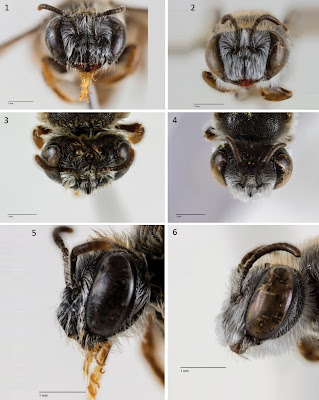 |
| Leioproctus zephyr Prendergast, 2022 DOI: 10.3897/jhr.93.85685 |
Abstract
A new species Leioproctus zephyr (Hymenoptera: Colletidae) is described from both sexes. Leioproctus zephyr sp. nov. is remarkable in featuring a large longitudinal ridge on the clypeus. This diagnostic morphological feature present in both sexes, along with various other distinctive characters including the male genitalia, female hind-tibial spur, and glossa morphology, clearly distinguish this species from all other Leioproctus. Along with these unique traits, L. zephyr cannot be classified into any of the existing subgenera of Leioproctus, sharing some, but not all, of the characters of the subgenera Ceratocolletes, Charicolletes, Protomorpha and Odontocolletes. DNA barcoding with the CO1 gene confirmed the sexes belonged to the same species and it did not match any previously barcoded species. This species is restricted to native vegetation remnants in the southwest Western Australian biodiversity hotspot, and is highly specialised, foraging only on a few species in the genus Jacksonia (Fabaceae). The unusual clypeus may be an adaptation for foraging on the keeled papilionaceous flowers. The limited number of sites this species has been collected from and its oligolectic diet suggest L. zephyr should be considered to be a species of conservation concern. Further taxonomic research is required to determine the phylogenetic position of this unusual Leioproctus.
Keywords: Australia, biodiversity hotspot, colletid, DNA barcoding, new species, specialist
 |
| Leioproctus zephyr sp. nov., emphasising the protruberant clypeus. Frontal view 1 female 2 male; dorsal view 3 female 4 male; lateral view 5 female 6 male. Photographs by N. Tatarnic. |
Leioproctus zephyr Prendergast, sp. nov.
Etymology: The species is named after the author’s beloved Maremma dog, Zephyr. The name “zephyr” is proposed as a noun in apposition.
Kit S. Prendergast. 2022. Leioproctus zephyr Prendergast (Hymenoptera, Colletidae, Leioproctus), An Oligoletic New Bee Species with A Distinctive Clypeus. Journal of Hymenoptera Research. 93: 167-188. DOI: 10.3897/jhr.93.85685
